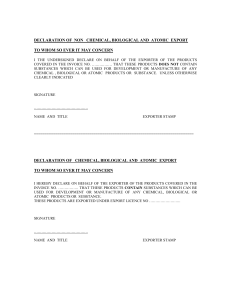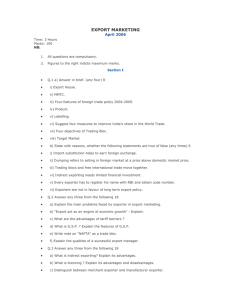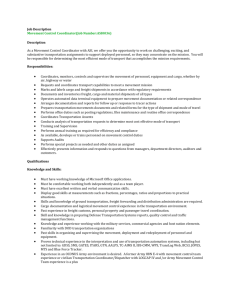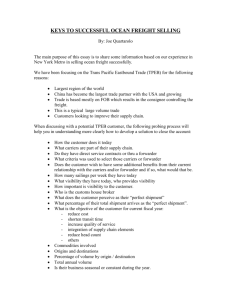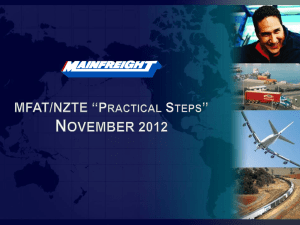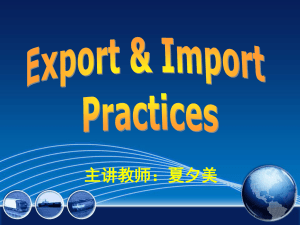Guide To Exporting Fresh Produce - NAMISTT
advertisement
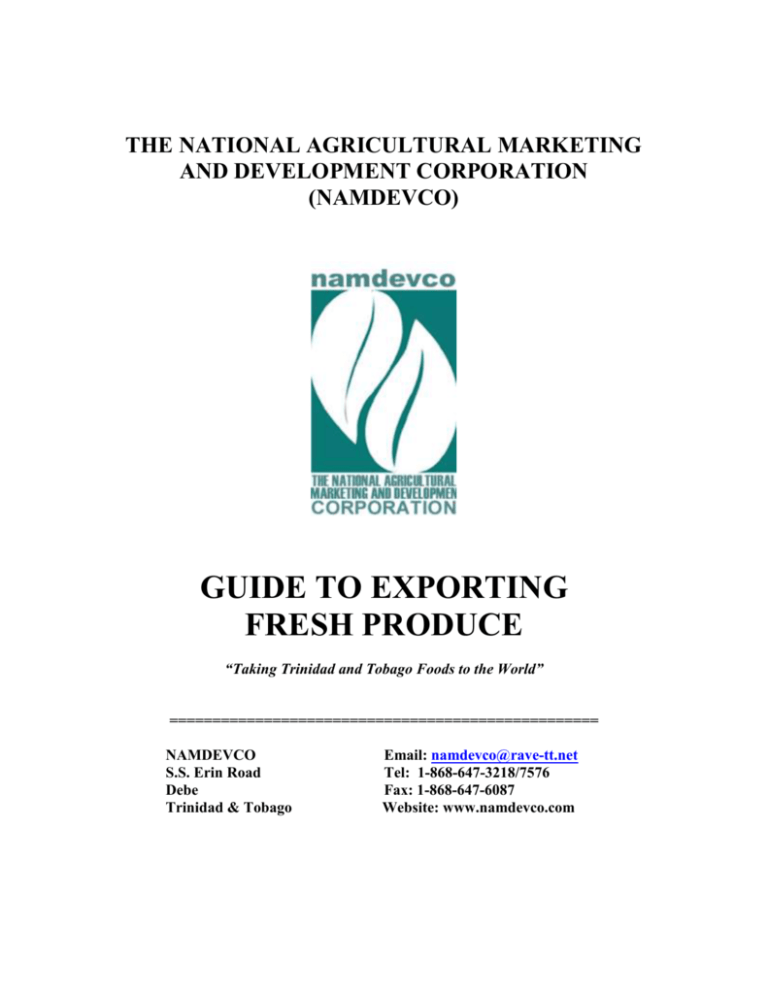
THE NATIONAL AGRICULTURAL MARKETING AND DEVELOPMENT CORPORATION (NAMDEVCO) GUIDE TO EXPORTING FRESH PRODUCE “Taking Trinidad and Tobago Foods to the World” ================================================== NAMDEVCO S.S. Erin Road Debe Trinidad & Tobago Email: namdevco@rave-tt.net Tel: 1-868-647-3218/7576 Fax: 1-868-647-6087 Website: www.namdevco.com TABLE OF CONTENTS Page 1.0 Introduction ………………………………………………………… 2 2.0 Regulations …………………………………………………………. 2 3.0 Know Your Market …………………………………………………. 2 Market Research ……………………………………………………. 2 4.0 Selection of Importer ……………………………………………….. 3 5.0 Export Pricing ………………………………………………………. 4 6.0 Making a Shipment …………………………………………………. 5 7.0 Terms of Payment …………………………………………………… 6 8.0 Documentation ……………………………………………………… 6 9.0 International Trade Terms ………………………………………….. 7 10.0 Other Relevant Terms ……………………………………………… 8 11.0 Support Services for Exporters ……………………………………. 9 12.0 Freight Service Providers ………………………………………….. 11 13.0 Appendix I - List of items shipped to each country………………….. 13 14.0 Appendix II - Export Forms …………………………………………. 14 A. Customs Form C82 ……………………………………………… 14 B. CARICOM Invoice ……………………………………………… 16 C. Airway Bill ……………………………………………………… 17 D. Bill of Lading ……………………………………………………. 18 E. Phytosanitary Certificate ………………………………………… 19 F. EUR 1 Form ……………………………………………………… 20 1 1.0 INTRODUCTION The advent of globalization and trade liberalization has resulted in increased growth in the trade in agricultural products. Trinidad and Tobago like many other countries has over the years been exporting its fresh produce to the region as well as to the U.S.A, Canada and the European Union countries mainly to the United Kingdom. This country exports a range of products to these various markets (see Appendix I for list of items shipped to each country). In order to successfully export produce, exporters must follow procedures and guidelines involve Customs, health and other regulations. This Guide to the Export of Fresh Produce seeks to address all the procedures involved and make it easy for the exporter to do business. 2.0 REGULATIONS An individual, partnership or registered company can be an exporter. There are no restrictions on who or what type of business can export from the country but the products must comply with existing export regulations. Commercial shipments leaving the country must be declared with the Custom and Excise Department. This declaration to Customs must be made by a licensed Customs broker appointed by the exporter. Fresh produce exports must comply with Phytosanitary regulations. To do so the shipment must be presented to the Plant Quarantine Office at the air or sea port or in some cases at the NAMDEVCO Packinghouse for inspection. Once the shipment is passed fit for export a Phytosanitary Certificate is issued. This Certificate must accompany the other shipping documents sent to the importer. 3.0 KNOW YOUR MARKET Market Research You must have known what your target market wants. In order to get this information, market research must be undertaken. This research can be done by you or someone employed by you. The objective of research is to provide the required information on which to base your export strategy. 2 There are two types primary and secondary. Secondary Research This is the process of gathering information within Trinidad and Tobago. The possible sources of secondary information are NAMDEVCO which is the agency mandated to facilitate market development for the country’s agri food products will be the main source of primary information. Other sources are: The Internet, Embassies/High Commissions Business Organisation such as Chambers of Commerce Primary Research This is the process of gathering information in the target market. It involves visiting the target market to get information by speaking to importers/distributors and or wholesalers as well as visiting Trade Fairs/Exhibitions It is advisable to gather as much information from secondary research before undertaking research in the market place. Primary research would seek to get information on; Economic overview of target market Import regulations Duties and taxes Distribution network Current suppliers Prices Listing of potential buyers Trading terms Packaging and presentation These are just some of the main factors to consider when seeking to venture into the export market. 4.0 SELECTION OF IMPORTER This is a very important process in exporting. You want to ensure that the person/company you are dealing with is reliable, and has a good history in the timeliness of remitting payments. 3 There are references sources that give background details on importers. For example for the U.S and Canadian markets there is the Red Book Credit Services which provides this kind of information. NAMDEVCO has a copy of the Red Book for use by current and potential exporters. In addition the EXIMBANK does background checks on importers on behalf of exporters using their export financing facility. 5.0 EXPORT PRICING Once you have established market prospects as well as potential buyers, the next step is to calculate the price to be quoted to the importer. The price can either be FOB, C&F or CIF. The following elements are included in an export pricing model. EXPORT PRICING MODEL PURCHASE PRICE OF PRODUCE TRANSPORT COSTS TO PACKINGHOUSE PROCESSING AND PACKAGING COSTS AT PACKINGHOUSE TRANSPORT COSTS TO AIR/SEA PORT CUSTOMS BROKER FEES EXPORTERS MARK UP = FREE ON BOARD PRICE (FOB PRICE) AIR OR SEA FREIGHT CHARGES = COST AND FREIGHT PRICE TO IMPORTER (C&F PRICE) INSURANCE = COST INSURANCE AND FREIGHT PRICE (CIF PRICE) 4 6.0 MAKING A SHIPMENT Once interest has been generated by the importer and he is satisfied with the price and terms such as method of payment, time of payment as well as conditions relating to spoilage etc are agreed, the exporter now swings into full gear to have the shipment ready. Depending on the type of item to be exported and the proximity to the market, the export can either ship by air or sea. A highly perishable product like Hot Peppers is sent by air while bulk items like Pumpkins is sent by sea. The choice between air or ocean freight depends on: cost destination storage life of produce frequency of shipping transit time risks involved size and weight of shipment The exporter has to make the following arrangements in order to make a shipment a) Source the produce from the farmer(s) b) Arrange transport to deliver to packinghouse for processing and packaging. c) If using NAMDEVCO or other packinghouse arrange time of delivery for processing d) Book the required cargo space with airline or shipping company as required e) Provide details of shipment to Customs Broker to have export documentation prepared and processed f) If shipping to the U.S.A ensure you are registered with the US Food and Drugs Administration(FDA) re the BioTerrorism Act (NAMDEVCO can assist with this).Upon registration each exporter will be issued a Personal Identification Number(PIN).This has to be used for advising the FDA(Prior Notice) on details of every shipment made. Prior Notice must be sent to the FDA and confirmed by them no more than 5 days before arrival of a shipment in the U.S and no less than 4 hours for shipment by air and 8 hours for shipment by sea. g) Arrange with Plant Quarantine Office at air or sea port to have produce inspected for Phytosanitary Certificate to be issued. Users of the NAMDEVCO Packinghouse can arrange for the Plant Quarantine Officer to do inspection at this facility. h) Arrange appropriate transport of packed produce to air or sea port by the required time 5 7.0 TERMS OF PAYMENT There are a number of ways that payment can be made. The common ones for agri food products are: Advance Payment - the exporter is paid before the shipment of goods. This is the ideal form of payment for the exporter. This may not always be possible however. Open Account - the exporter is paid after the goods have been received by the importer and found to be acceptable. 8.0 DOCUMENTATION (Copies of all these documents are shown in the Appendix I) C 82 Form Customs Declaration Form, also called the 'Shipping Bill' Used for Imports and Exports of Goods Must be filled out completely and accurately by a licensed customs broker Used for compiling statistics of a country’s import and export. CARICOM Invoice Represents a legal document between buyer and seller Must be filled out completely and accurately by a licensed customs broker Used for imports and exports Gives a detailed description of the shipment, e.g. number and weight of each package This document must be signed by the exporter or his representation. Airway Bill (Air Freight) Prepared by the airline Made up of three (3) original copies. One each for the exporter, importer and the airline A receipt from the airline acknowledging it has received the consignment from the exporter Internationally standardized document Gives the exporter right of disposal Allows the importer/ receiver to receive the goods. Bill of Lading (Sea Freight) 6 Prepared by the shipping company Made up of three (3) original copies. One each for the exporter, importer and the shipper Completed by the exporter or his freight forwarder Two (2) types – CARICOM – when shipping via the CARICOM Jetty International – each shipping line has its own format A receipt from the shipper acknowledging that it has received the consignment from the exporter A document of title giving ownership of the goods An exporter may wish to use the services of a freight forwarding agent to simplify the documentation process. The freight forwarder will handle all the necessary documents for a fee. Phytosanitary Certificate Issued by the Plant Quarantine Section Free of Charge Confirms produce is treated and/or free from pest and disease Also states place of origin EUR1 Form This is a Certificate of Origin and is required for trade between African, Caribbean and Pacific (ACP) countries and the European Union. Duty free form for entry into the European Union, including dependencies in the Caribbean Also known as a movement certificate Used for trace ability of shipment Certified by Customs 9.0 INTERNATIONAL TRADE TERMS International trade has specific trade terms which an exporter must be familiar with. Some of the terms that would apply to exporters of agric food products are listed below. FOB (Free on Board) – this term indicates the seller is responsible for all costs up to the point of delivery at the air or sea port. In such a situation the importer is responsible for the freight and other charges in order to get the goods into his warehouse. C & F (Cost and Freight) – If the terms between the exporter and importer are C&F the exporter pays all costs up to the point of arrival at the designated air or sea port in the importing country. CIF (Cost, Insurance and Freight) – The seller is responsible for all costs including insurance up to the point of arrival at air or sea port in the importing country. 7 FOB and C&F terms are the more commonly used in the export of fresh produce. Based on the agreement between the exporter and importer, the quotation by the former would reflect which of the above term is to be used. 10.0 OTHER RELEVANT TERMS Airway Bill This is a contract to carry goods by air. This document is provided by the airline on the day of the shipment and includes details of buyer, seller, items exported and weight. The Airway Bill is sent together with all other relevant documents to the importer to enable clearance of the goods upon arrival. Bill of Lading This is a contract document which is used for products exported by sea. It is provided by the sea freight company. It contains the same information as the Airway Bill. Consignee The person to whom the shipment is sent, the importer Consignor The person who sends the shipment, the exporter Container Vessel This is a vessel that only carries containerized cargo. Containers are 20 or 40 feet, some are refrigerated. Pumpkins are exported in 40 feet refrigerated containers. Freight Forwarder This is a company responsible for arranging freight with air or sea lines. Some freight forwarders handle both air and sea while others specialize in either one. NAMDEVCO can assist with a listing of freight forwarders or it can be obtained from the Yellow Pages in the Telephone Directory Freight Rate The rate charged for transporting cargo. Rates vary depending on destination and volume shipped. Freight forwarders and or cargo companies will provide rates. 11.0 SUPPORT SERVICES FOR EXPORTERS 8 NAMDEVCO The National Agricultural Marketing and Development Corporation (NAMDEVCO) is a State Agency mandated to promote marketing services and stimulate business investment in the agro-industrial sector. We can assist with: Identification of buyers Provision of market price information Market research information Listing of producers Packinghouse services Market promotion Contact details are: The National Agricultural Marketing and Development Corporation (NAMDEVCO) S.S Erin Road Debe Telephone - 647 – 3218/3467 Fax - 647 – 6087 Email: namdevco@tstt.net.tt Website: www.namdevco.com Packinghouse, Piarco Tel- 669 – 7092 Fax- 669 – 7091 PLANT QUARANTINE DIVISION This Division of the Ministry of Agriculture, Land and Marine Resources is responsible for the inspection and certification of all fresh leaving the country. Contact details are: Piarco International Airport Tel 669-4860 Port of Spain Wharf Tel 625-3266 Point Lisas Port Tel 636-0883 EXIMBANK OF TRINIDAD & TOBAGO 9 This organization provides financing and insurance packages for exporters. The EXIMBANK has an Agricultural Policy catering to the needs of exporters of agri food products. This Policy is focused on promoting and supporting the export of locally produced agricultural products (fresh and processed). The policy protects an exporter of agricultural products from failure of its overseas customer/buyer to make agreed payments because of unforeseen commercial credit or political risks. Contact details are: EXIMBANK Exim House Marketing and Business Development 30 Queen’s Park West Port of Spain Tel 628- 2762/1382 Fax 628-622-3545 Email: eximbank@wow.net Website: www.eximbanktt.com AGRICULTURAL DEVELOPMENT BANK OF TRINIDAD & TOBAGO (ADB) The ADB provides financing for agro enterprises; both fresh and processed food producers. Under the GroSafe Loan package, the ADB provides two facilities. One is for producers in the Farm Certification and Monitoring Programme administered by NAMDEVCO, the other is for marketers who buy produce from these Certified farms. For further details on how to access funding, contact the ADB at their Head Office or any of their Branch Offices. Contact details for ADB Head Office are: 87 Henry Street Port of Spain Tel 623-6261/5 Fax 624-3087 Email adbpos@adbtt.com 12.0 FREIGHT SERVICE PROVIDERS 10 Air Freight BWIA International Cargo Division Piarco International Airport Piarco Tel: 1-868-669-3000 ext 2668, 2663, 2671, 2443 Fax: 1-868-669-1973 Email: bweecargo@bwee.com Amerijet Caribbean Express Limited Cargo Department South Side Piarco International Airport Piarco Tel: 1-868-669-3221/0004/0007 Fax: 1-868-669-2003 Email: ace.pos@amerijet.com American Airlines Cargo General Aviation Services Limited Piarco International Airport Piarco Tel: 1-868-669-2630/2635 Fax: 1-868-669-0267 Email: cargo@gas.co.tt Air Canada Cargo c/o Piarco Air Services Cargo Complex Caroni North Bank Road Piarco Tel: 1-868-669-4076/5285 Fax: 1-868-669-5194 Email: cargo@pasl.co.tt 11 Laparkan Shipping Cargo Complex Piarco International Airport Piarco Tel: 1-868-669-0287/7427 Fax: 1-868-669-0283 Email: fyzallpk@carib-link.net Sea Freight Tropical Shipping Lot 18 Trincity Business Park Golden Grove Road Piarco Tel: 1-868-692-5400/5402 Fax: 1-868-692-5442 Email: ebelcon@tropical.com or rmilford@tropical.com Seaboard Marine Trinidad Limited Port of Spain Main Office Atlantic Avenue P.O. Box 5225 Tel: 1-868-679-6370/1570 Fax: 1-868-679-6267 Email: info@seaboardtrinidad.com Maersk Trinidad Ltd Fitt House Fitt Street Woodbrook Port of Spain Tel 627-5746, 624-9349 Fax 627-8023 This list is not exhaustive nor does it indicate a recommendation of the companies listed 12 13.0 LIST OF ITEMS SHIPPED TO EACH COUNTRY – Appendix I COUNTRIES Barbados LIST OF ITEMS SHIPPED Cabbage, Okra, Tomato, Sweet Pepper, Watermelon, Squash, Pumpkin, Pineapple, Cucumber, Cauliflower, Christophene, Citrus, Egg plant, Papaya St. Lucia Peas and beans, Melons, Cucumber, Pumpkin, Tomato, Peppers United States Mainly Hot Peppers and Pumpkin Canada Pumpkins, Egg plant, Hot Peppers, Sweet Potatoes, Mangoes 13 14.0 EXPORT FORMS – Appendix II A. CUSTOMS FORM C82 (Front) 14 A. (Cont’d): CUSTOMS FORM C82 (Back) 15 B. CARICOM INVOICE 16 C. AIRWAY BILL 17 D. BILL OF LADING 18 E. PHYTOSANITARY CERTIFICATE 19 F. EUR 1 FORM (Front) – Certificate of Origin for Exports to the European Union 20 F. (Cont’d) EUR 1 FORM (Back) 21
